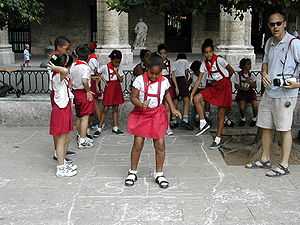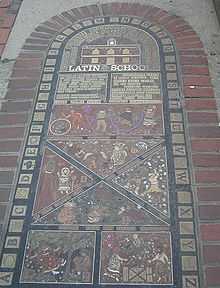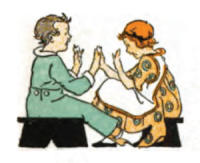Hopscotch

Hopscotch is a children's game that can be played with several players or alone. Hopscotch is a popular playground game in which players toss a small object into numbered spaces of a pattern of rectangles outlined on the ground and then hop or jump through the spaces to retrieve the object.
Court and rules

| Hopscotch Courts, c. 1900.[1] | ||
|---|---|---|
 |
 |
 |
The court (or course)
To play hopscotch, a course is first laid out on the ground. Depending on the available surface, the course is either scratched out in dirt, or drawn with chalk on pavement. Designs vary, but the course is usually composed of a series of linear squares interspersed with blocks of two lateral squares. Traditionally the course ends with a "safe" or "home" base in which the player may turn before completing the reverse trip. The home base may be a square, a rectangle, or a semicircle. The squares are then numbered in the sequence in which they are to be hopped.
Playing the game
The first player tosses the marker (typically a stone, coin or bean bag) into the first square. The marker must land completely within the designated square and without touching a line or bouncing out. The player then hops through the course, skipping the square with the marker in it. Single squares must be hopped on one foot. For the first single square, either foot may be used. Side by side squares are straddled, with the left foot landing in the left square, and the right foot landing in the right square. Optional squares marked "Safe", "Home", or "Rest" are neutral squares, and may be hopped through in any manner without penalty. After hopping into the "Safe", "Home", or "Rest" the player must then turn around and return through the course (square 9, then squares 8 and 7, next square 6 and so forth) on one or two legs depending on the square until he or she reaches the square with their marker. They then must retrieve their marker and continue the course as stated without touching a line or stepping into a square with another player's marker.
Upon successfully completing the sequence, the player continues the turn by tossing the marker into square number two, and repeating the pattern.
If, while hopping through the court in either direction, the player steps on a line, misses a square, or loses balance, the turn ends. Players begin their turns where they last left off. The first player to complete one course for every numbered square on the court wins the game.
Although the marker is most often picked up during the game, historically, in the boy's game, the marker was kicked sequentially back through the course on the return trip and then kicked out.
Origin

It is attested that an ancient form of hopscotch was played by Roman children,[2] but the first recorded references to the game in English-speaking world date back to the late 17th century, usually under the name "scotch-hop" or "scotch-hopper(s)".[3] A manuscript Book of Games compiled between 1635 and 1672 by Francis Willughby refers to 'Scotch Hopper‥. They play with a piece of tile or a little flat piece of lead, upon a boarded floore, or anie area divided into oblong figures like boards'.[4] In Poor Robin’s Almanack for 1677, the game is referred to as "Scotch-hoppers". The entry states, "The time when schoolboys should play at Scotch-hoppers." The 1707 edition of Poor Robin’s Almanack includes the following phrase… "Lawyers and Physicians have little to do this month, so they may (if they will) play at Scotch-hoppers."[5] In 1828 Webster's An American Dictionary of the English language also referred to the game as 'Scotch-hopper'...'a play in which boys hop over scotches and lines in the ground.'[6]
Since the game was known and popular in the seventeenth century, it is logical to suppose it may have existed at least a few decades (or perhaps even many centuries) before its earliest literary reference; but no conclusive evidence has yet been presented to support this theory.
Etymology
According to the Oxford English Dictionary the etymology of hopscotch is a formation from the words "hop" and "scotch", the latter in the sense of "an incised line or scratch"[7] The journal of the British Archaeological Association, Volume 26 (dated March 9, 1870) states, "The sport of Hop-Scotch or Scotch-Hoppers is called in Yorkshire 'Hop-Score,' and in Suffolk 'Scotch Hobbies or Hobby,' from the boy who gets on the player's back whilst hopping or 'hicking,' as it is there termed; and in North Britain it is known as 'Peevers, Peeverels, and Pabats.'"
Variations

There are many other forms of hopscotch played across the globe.[8] In India it is called Stapu or Kith-Kith, in Spain and some Latin American countries, it's rayuela, although it may also be known as golosa. In Russian it is known as классики (diminutive for the word meaning classes). In Israel it is called "klahss." In Poland, it is called klasy, meaning classes. In Italy it is called campana (meaning bell), or mondo (meaning world). In the Netherlands and Flanders, Hinkelen. In Bosnia, Croatia and Serbia it is called školica, meaning little school. In Malaysia the most popular variant is called tengteng. In Mexico, it is called bebeleche (mamaleche) meaning drink milk or avioncito meaning little plane ("probably because of the shape"). In Cuba and in Puerto Rico it is called "La Peregrina" (meaning "Pilgrim Girl") and the squares represents the 9 rings the pilgrim traveler has to pass in order to reach Heaven from Purgatory according to Dante's Inferno. In Romania the game is called șotron and is widely played by children all over the country. In Brazil it is called amarelinha. The name evolved from marelle, the French name for the game, but was identified to the radical amarelo (yellow) and its diminutive in -inho/a. In Breton, the name is reg or delech. The Albanian variant is called rrasavi, which is composed of two words: rrasa ("the flat stone", an object used to play the game) and vi ("line", a reference to the lines that comprise the diagram of the course). In Philippines, hopscotch is called "piko" (pee-ko). In India, hopscotch is called "thikrya", because broken stones called 'thikrya' are slid across the grid as players hop to next squares.
Laylay (or Khane bazi)

The game's generic name in Persian is Laylay. The most common form of Laylay in Iran resembles the older Western types and uses six or more (always an even number) side-by-side squares successively (vertically) numbered. The player uses a peg or a flat stone that the player must kick to the next square as the player is hopping. If either the stone or a player's foot lands on a line, the player forfeits the game (or loses a turn). Although somewhat less common, the contemporary Western type is also played.
Peevers or Peever
In Glasgow, the game is called "beds" or "Peever(s)". "Peever" is also the name of the object which is slid across the grid to land in a square. In the 1950s and 1960s in Glasgow, it was common for the peever to be a shoe polish tin filled with stones or dirt and screwed shut.[9][10]
Escargot
A French variant of hopscotch is known as escargot (snail) or marelle ronde (round hopscotch). It is played on a spiral course. Players must hop on one foot to the center of the spiral and back out again.
If the player reaches the center without stepping on a line or losing balance he or she marks one square with his or her initials, and from then on may place two feet in that square, while all other players must hop over it. The game ends when all squares are marked or no one can reach the center, and the winner is the player who "owns" the most squares.[11]
Himmel und Hölle
In Germany, Austria, and Switzerland the game is called Himmel und Hölle (Heaven and Hell) although there are also some other names used, depending on the region. The square below 1 or the 1 itself are called Erde (Earth) while the second to last square is the Hölle (Hell) and the last one is Himmel (Heaven). The first player throws a small stone into the first square and then jumps to the square and must kick the stone to the next square and so on, however, the stone or the player cannot stop in Hell so they try to skip that square.
Kith-Kith

In India, hopscotch is also called kith-kith, Stapu, or Ekhat-Dukhat (meaning one two houses) in the Hindi-speaking areas, Kunte bille in Karnataka, Paandi in Tamil Nadu, Tokkudu Billa in Andhra Pradesh. These games have similar principles in that players must hop on one foot and must throw the marker in the right square. This mostly is a girls' game in India, though some boys play them too.
Potsy
Hopscotch was/is called Potsy in New York City.[12]
Amarelinha
In Brazil, this game is called Amarelinha.
Australian Hop Scotch
In Australia, hopscotch is played in stages. First stage is played by hopping per the standard rules. Once this stage is complete, the player is promoted to the next stage called "jumps" where the player jumps into each square with two feet. Final stage is the most difficult stage called "sizzles", which is similar to jumps except the legs are crossed. The first player to complete all three stages wins. If a player touches a line, he is demoted to the start of his current stage. For younger players, "helps" can be used. These are lines typically extended at the sides between squares 2 and 3 so younger players can use these to get closer to throwing the "tor" into the required square.

World record
The current Guinness Book of World Records holder for the fastest hopscotch game is Ashrita Furman, at 1 minute and 8 seconds.[13]
Popular culture
A 2010 PBS documentary, New York Street Games, includes potsy, which is described as a "girl's game".[14]
Julio Cortazar based his novel Hopscotch on this game.
References
- ↑ Beard, D.C. (1907). The Outdoor Handy Book: For the Playground, Field, and Forest. New York: Charles Scribner's Sons. pp. 356–357.
- ↑ "Hopscotch - Toys and Games".
- ↑ Thomas Shadwell (1668). The Sullen Lovers. :'Play at Catt, Stoolball, Scotch-hopp and Trap-ball.' Cited in Oxford English Dictionary, Third edition, June 2011; online version March 2012
- ↑ The manuscript was published in 2003: see Cram, David, Forgeng, Jeffrey L. and Johnston, Dorothy, The Book of Games of Francis Willughby (1635-1672). A Seventeenth-century Treatise on Sports, Games and Pastimes (Aldershot, 2003)
- ↑ The journal of the British Archaeological Association, Volume 26.
- ↑ Oxford English Dictionary, Third edition, June 2011; online version March 2012
- ↑ OED Online. March 2012. Oxford University Press. 24 April 2012: 'scotch: An incision, a cut, esp. a long gash made in the flesh; a score; a notch. Obs. (arch. and Eng. regional (E. Anglian) in later use).'
- ↑ Lankford, Mary T.; Karen Dugan (1992). Hopscotch Around the World. New York: William Morrow. ISBN 0-688-14745-3.
- ↑ http://www.scotslanguage.com/articles/words/601
- ↑ http://www.ourglasgowstory.com/story.php?sid=48&start=0&end=14&id=1075906452&o=
- ↑
- ↑ The Big Apple: Potsy. Retrieved 2010-05-19.
- ↑ "Crayola Outdoor Challenge".
- ↑ New York Street Games (Motion picture). New York City. Retrieved 14 Nov 2011. Unknown parameter
|people2=ignored (help); Unknown parameter|people1=ignored (help)
External links
| Wikimedia Commons has media related to Hopscotch. |
| |||||||||||||||||||||||||||||||
